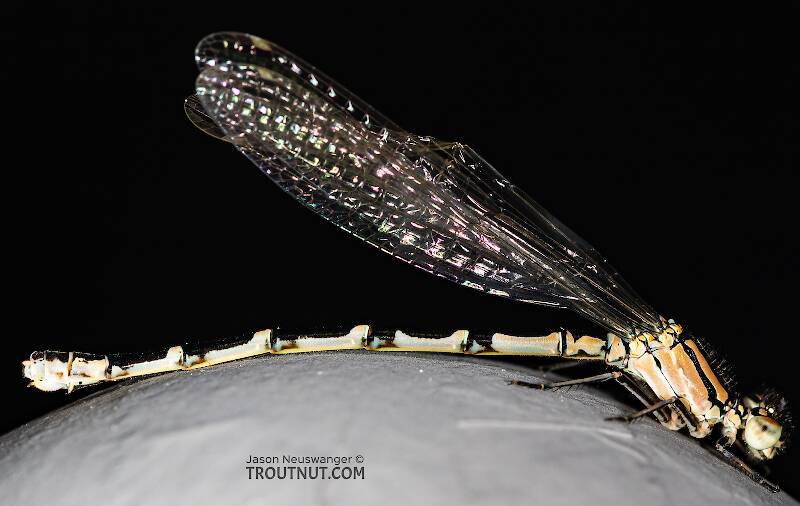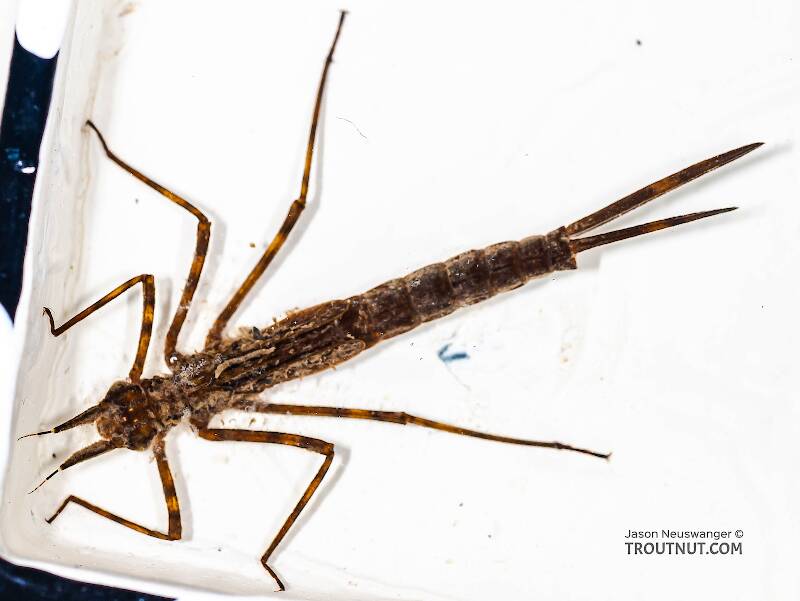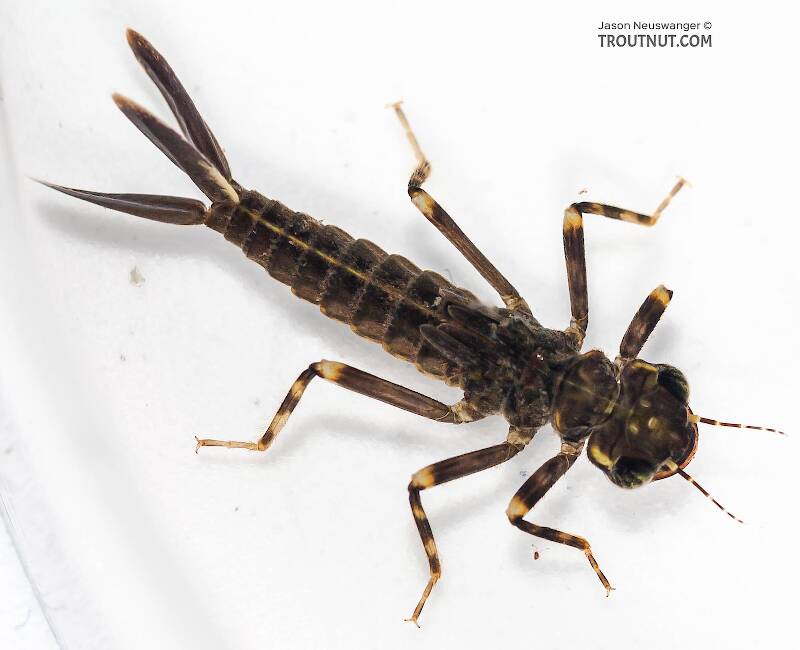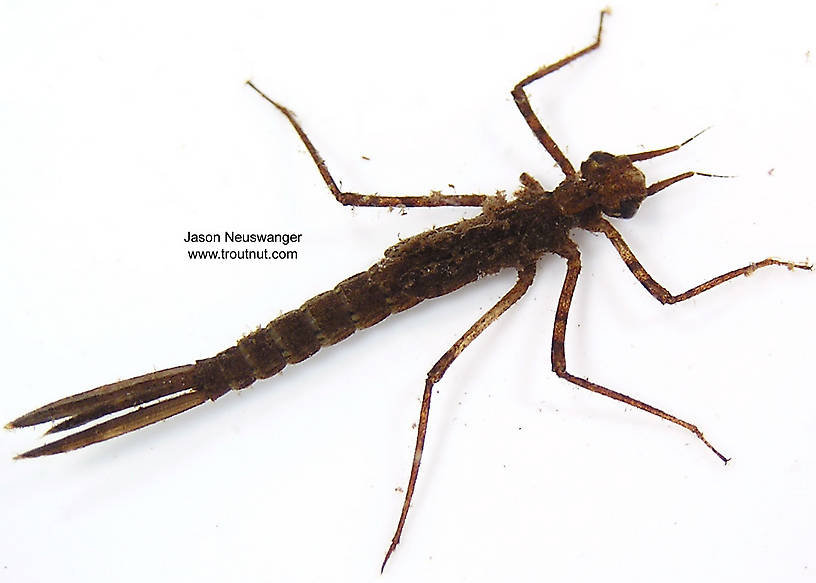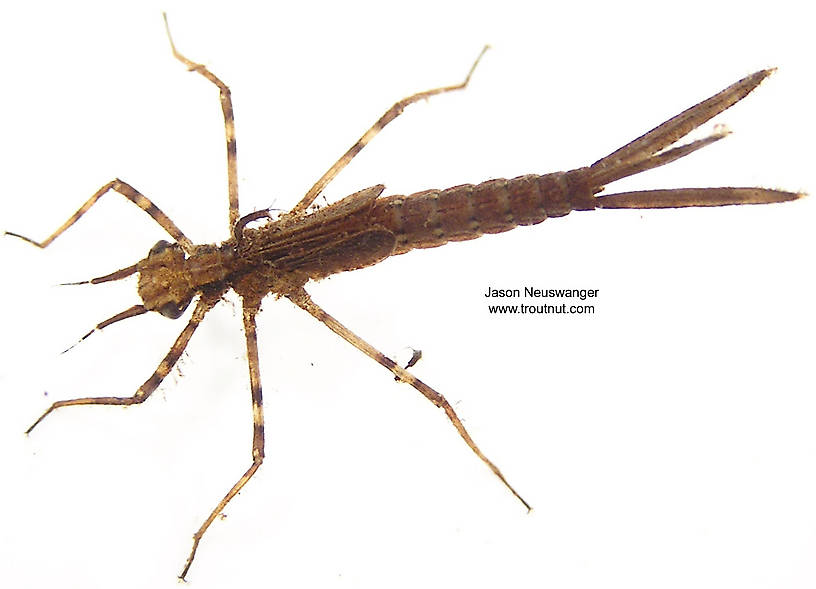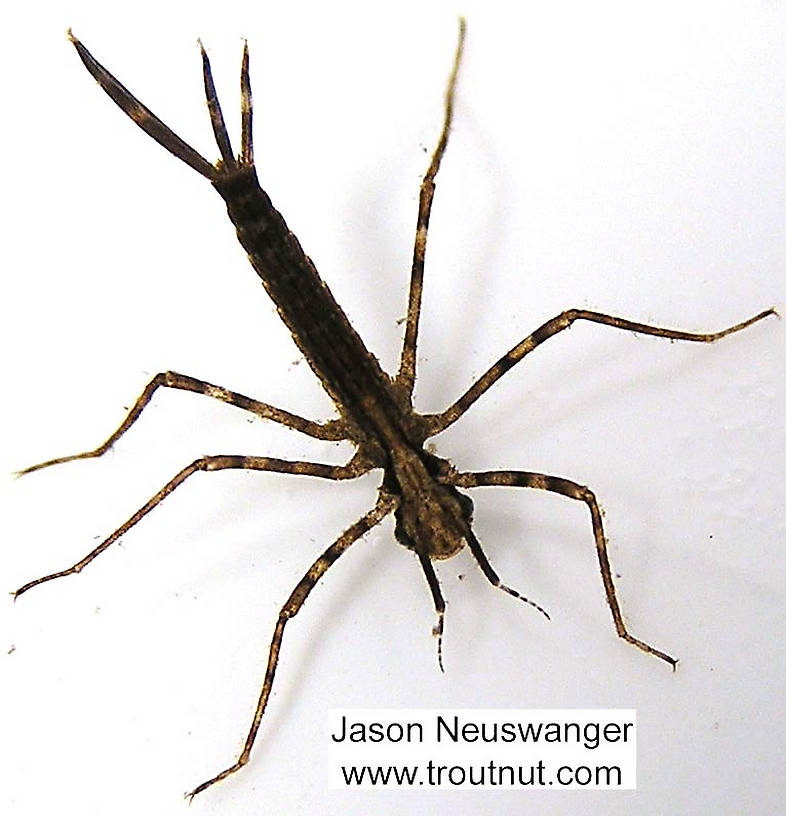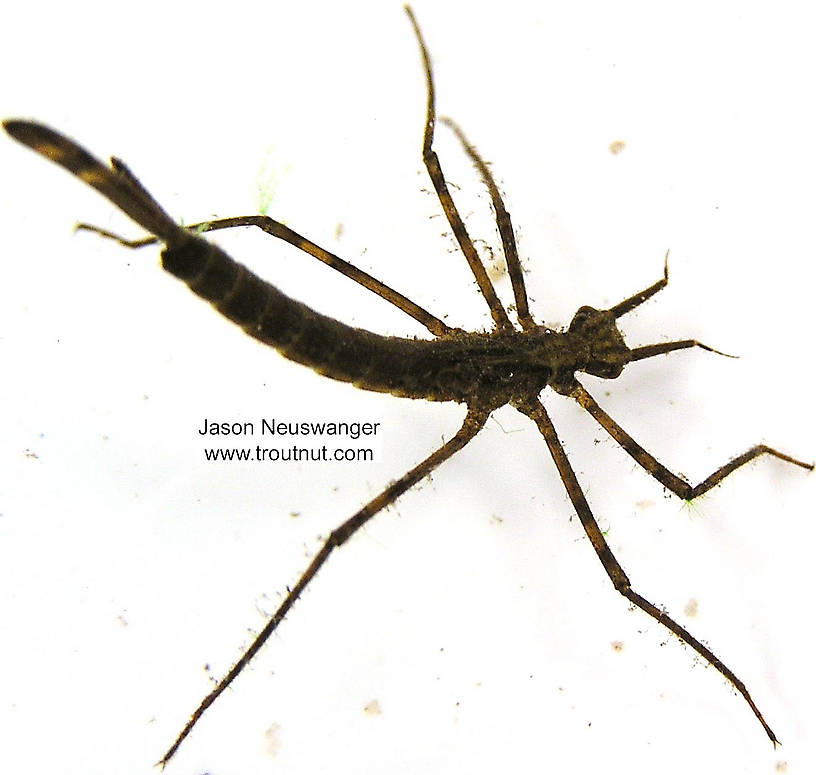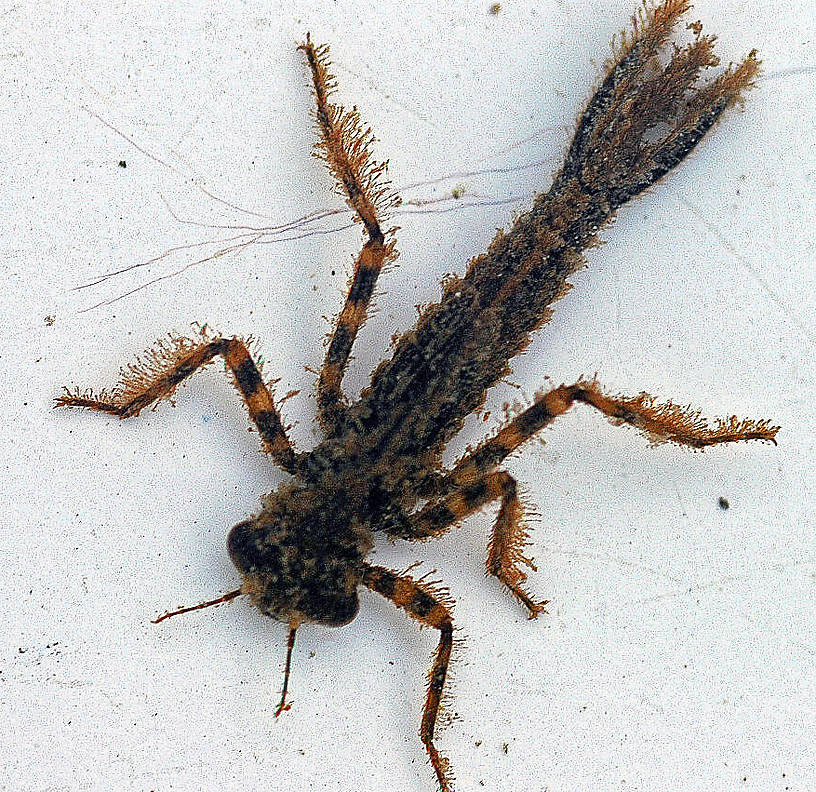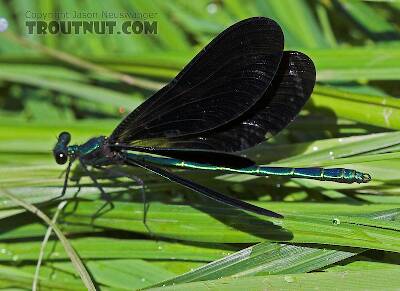
Hex Mayflies
Hexagenia limbata
The famous nocturnal Hex hatch of the Midwest (and a few other lucky locations) stirs to the surface mythically large brown trout that only touch streamers for the rest of the year.
Featured on the forum

This one was surprisingly straightforward to identify. The lack of a sclerite at the base of the lateral hump narrows the field quite a bit, and the other options followed fairly obvious characteristics to Clostoeca, which only has one species, Clostoeca disjuncta.

Troutnut is a project started in 2003 by salmonid ecologist Jason "Troutnut" Neuswanger to help anglers and
fly tyers unabashedly embrace the entomological side of the sport. Learn more about Troutnut or
support the project for an enhanced experience here.
Insect Order Odonata-Zygoptera (Damselflies)
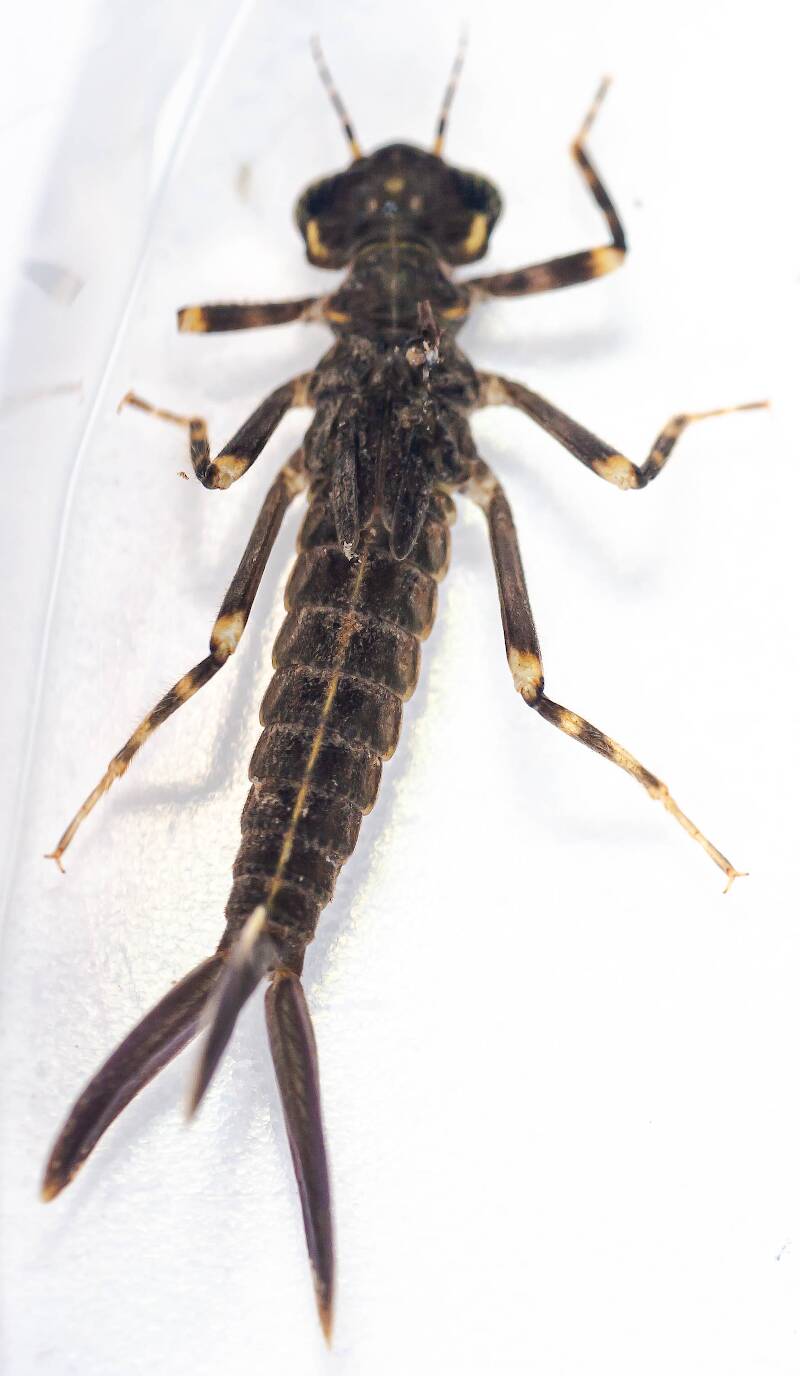
Damselflies and dragonflies are in the same order, Odonata, but they are taxonomically separated on an obscure level not built into this site, the suborder. Damselflies are in the suborder Zygoptera, the scientific name by which they're most known. None of that will help you catch trout, but it explains what the hyphen in this page's title is all about.
Biologically, damselflies are similar to dragonflies (Odonata-Anisoptera) in most of the ways that matter to the angler.
Nymph biology
Like the adults, the nymphs are fierce predators. They differ from dragonflies in that they are very slender with long, spindly legs, and they swim by awkwardly wiggling rather than using the dragonfly's natural jet propulsion.Specimens of Damselflies:
1 Adult
7 Nymphs
1 Streamside Picture of Damselflies:
Discussions of Odonata-Zygoptera
Damsefly Nymphs: Odonata Zygoptera
3 replies
Posted by WildcatRob on Dec 9, 2007
Last reply on Aug 29, 2011 by Sayfu
While Damselflies are not of great interest to the stream fisher, they are of great interest to the lake fisher.
Creatures of shallow, non fluctuating, weed filled trout lakes, Damsel nymphs migrate in mass to shore for their final molt. As the reach shore the climb out on emergent foliage, lock their claws into and wait while the exoskelton splits to reveal the most graceful of acquatic insects (I'm ducking the brickbats.)
The migration is relatively slow and close to surface with zigzags and pauses.
Mature damsels fold their wings parallel to the body, while hatched dragons hold their wings perpendicular to the body. Mature Damsels are of little interest to trout.
A damsel hatch will put all the really big trout in a lake in motion. These hogs like to get right up against the emergent vegetation picking the nymphs off as they start to climb out.
Anyone who has fished a damsel emergence will never forget the experience. Having experienced one, I am most fortunate. Because you would count me amongst the great liars of our sport, I won't tell the whole story.. The brief facts are: In less than 90 minutes 3 cutthroat - 7+ pounds total, one lost and one over 6 pounds scared away. The lake is Lenice. It's public. It's reknown for huge cutthroat. It's a challenge.
For a compact Odonta/damsel reference, I recommend 'The Gilly' A Flyfisher's Guide, Edited by Alfred G. Davy 1985 IBSN 0-88925-638-1 pp 69-74 as one of many compact references.
WildcatRob
Creatures of shallow, non fluctuating, weed filled trout lakes, Damsel nymphs migrate in mass to shore for their final molt. As the reach shore the climb out on emergent foliage, lock their claws into and wait while the exoskelton splits to reveal the most graceful of acquatic insects (I'm ducking the brickbats.)
The migration is relatively slow and close to surface with zigzags and pauses.
Mature damsels fold their wings parallel to the body, while hatched dragons hold their wings perpendicular to the body. Mature Damsels are of little interest to trout.
A damsel hatch will put all the really big trout in a lake in motion. These hogs like to get right up against the emergent vegetation picking the nymphs off as they start to climb out.
Anyone who has fished a damsel emergence will never forget the experience. Having experienced one, I am most fortunate. Because you would count me amongst the great liars of our sport, I won't tell the whole story.. The brief facts are: In less than 90 minutes 3 cutthroat - 7+ pounds total, one lost and one over 6 pounds scared away. The lake is Lenice. It's public. It's reknown for huge cutthroat. It's a challenge.
For a compact Odonta/damsel reference, I recommend 'The Gilly' A Flyfisher's Guide, Edited by Alfred G. Davy 1985 IBSN 0-88925-638-1 pp 69-74 as one of many compact references.
WildcatRob
Stupid damselfly!
4 replies
Posted by Troutnut on May 29, 2007
Last reply on Jul 1, 2007 by Litobrancha
Today I was collecting nymphs in the Poconos with Gonzo when I spotted an interesting-looking spinner in the air and it landed next to us on a piece of grass. I grabbed it and tossed it in my bug box, and we both took a closer look.
It was a male spinner, perfect for identification, and it seemed to belong to a species of Ephemerella that neither of us recognized. The form was similar to invaria, more sleek than subvaria or Drunella. It was long, a big size 12 probably, but very thin. It had three long, elegant tails, and would generally have been a very photogenic mayfly.
I was looking forward to getting it under the camera and microscope to figure out what it was. But when I got home a little while ago and was looking through my bugs, it had disappeared!
Mostly.
I found a detached spinner wing of about the right size, dangling out of the mouth of a big damselfly I had added to the container. D'oh! Despite the stress of restriction to my container, and the fact that its wings were messed up, my crippled damselfly apparently hobbled its way over to my prized spinner and ate all but one wing.
It was a male spinner, perfect for identification, and it seemed to belong to a species of Ephemerella that neither of us recognized. The form was similar to invaria, more sleek than subvaria or Drunella. It was long, a big size 12 probably, but very thin. It had three long, elegant tails, and would generally have been a very photogenic mayfly.
I was looking forward to getting it under the camera and microscope to figure out what it was. But when I got home a little while ago and was looking through my bugs, it had disappeared!
Mostly.
I found a detached spinner wing of about the right size, dangling out of the mouth of a big damselfly I had added to the container. D'oh! Despite the stress of restriction to my container, and the fact that its wings were messed up, my crippled damselfly apparently hobbled its way over to my prized spinner and ate all but one wing.
Adult damsel
Posted by DMM on Feb 22, 2007
Last reply on Apr 14, 2007 by DMM
I didn't notice this Calopteryx adult before...it's beautiful.
Start a Discussion of Odonata-Zygoptera
References
- Schwiebert, Ernest G. 1955. Matching the Hatch. MacMillan Publishing Company.
- Swisher, Doug and Carl Richards. 2000. Selective Trout. The Lyons Press.
Insect Order Odonata-Zygoptera (Damselflies)
Taxonomy
Family in Odonata-Zygoptera: Calopterygidae, Coenagrionidae
2 families (Lestidae and Protoneuridae) aren't included.


